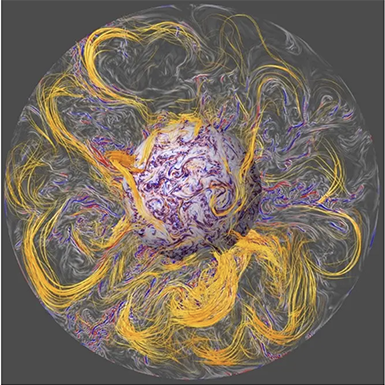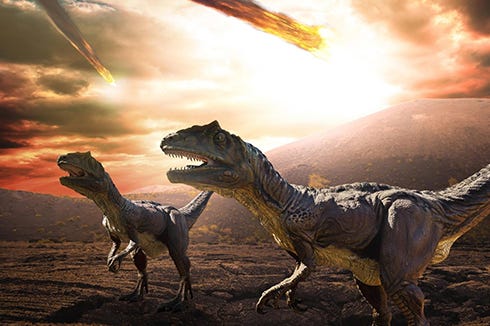There is no Planet A
Earth is no oasis, it's a small rock on a wild, chaotic ride through space - just like Mars.
There is ‘No Planet B’ is the phrase Democrats and environmental activists use to express their belief that humans are too weak and stupid to figure out how to live on Mars - but are powerful enough to control and maintain Earth’s climate at a constant, balanced equilibrium. We can do this by electing Democrats and environmental activists who will promptly and efficiently reduce carbon emissions by raising taxes and putting prohibitive restrictions on vehicles, factories, farmers and cow farts.
Armed with mathematical models and bureaucratic efficiency, these activists believe they can force our chaotic, complex Planet A, Earth to become safe and sustainable. But life is change. Nature abhors equilibrium.
‘No Planet B’ believer, actor William Shatner said this of his short trip on the Blue Origin space shuttle:
While I was looking away from Earth, and turned towards the rest of the universe, I didn’t feel connection; I didn’t feel attraction. What I understood, in the clearest possible way, was that we were living on a tiny oasis of life, surrounded by an immensity of death. I didn’t see infinite possibilities of worlds to explore, of adventures to have, or living creatures to connect with. I saw the deepest darkness I could have ever imagined, contrasting starkly with the welcoming warmth of our nurturing home planet.
Shatner saw Earth as being separate from space, but in fact, space is nature. Nature is space. Our ‘tiny oasis of life’ has always been a part and parcel of the immensity of space. The dinosaurs became aware of that. As we watch near-earth asteroids approach, hoping for a near miss, we’re aware of it too.
But those meteors brought life as well as death.
A wide range of evidence for pointing to our cosmic origins is close to the point of being overwhelming. Yet the long-entrenched paradigm of Earth-centered biology appears to prevail in scientific culture. - From the study ‘Experiments to prove continuing microbial ingress from Space to Earth.’
Trillions of viruses fall from the sky every day. Viruses are present in every species and every ecological niche, and affect every organism. Fragments of comets and interplanetary and interstellar dust particles are known to enter our atmosphere in vast quantity, at a more or less steady rate, averaging in excess of ~ 102 ton/day. Although much of this incoming material burns up as meteors, a significant fraction survives entry. Our tiny oasis is an ideal collector of interstellar microbes that can survive the vacuum of space and be carried via asteroids.
“The cosmos is within us. We are made of star-stuff. We are a way for the universe to know itself.”
―Carl Sagan
Relying only on our Earth-centered perception won’t help us understand the universe or ourselves. Our tiny oasis of life rotates at approximately 1,000 miles per hour (1,609.34 km/h) at the equator while blasting around the sun at a speed of 67,100 miles per hour (107.826 km/h). Meanwhile, the sun is dragging us around the galaxy as it spins at around 497,097 miles per hour (800,000 km/h).
Our perceptions tell us that we’re powerful enough to control the weather and all life on the planet, but they’re barely aware of the wild ride we’re on. For eons, our senses told us that the Earth is flat and the stars rotate around us. It’s taken centuries of scientific study, arguments, persecution and proof to learn the truth about our real place in the Universe..
The science that helped us understand our place in the Universe brought us to the moon and back. It helped us created the ISS. That same science made plans to colonize Planet B when Al Gore was in short pants. Viable plans for missions to Mars, using late 20th century technology included crewed flybys, crewed landers, and settlements.

No Planet B believers want us to trade exploration, discovery and new knowledge for degrowth, NetZero, and upcycling. We must not visit Mars, but they will let us greenwash ourselves in cold, infrequent showers.
Climate change activists may not be interested in space, but space is interested in them. It’s currently roiling beneath their feet.

According to the the giant-impact hypothesis, our Planet A was most likely created when the planet Theia collided with Earth around 4.5 billion years ago. Some of the resulting ejected debris coalesced to form the Moon. This collision also affected Earth’s inner and outer core, the superheated rotating nickel/iron blobs that creates the earth's magnetic field. This field shields the earth from solar radiation and allows life on earth to flourish.
No Planet B dreams of keeping Earth in a state of equilibrium, but the magnetic field and our survival depend on our superheated inner and outer core’s constant dynamic flux. The Earth’s crust is made up of constantly moving, colliding, fragmented plates. Over Planet A + T’s long history, subducted crustal material generated the buckling of the upper layers to create mountains, melted at depth to create batholiths, volcanoes and the magnetic field.
That field is also dynamic. Magnetic north is always on the move. It had been moving slowly around Canada since the 1500s, but in the past 20 years, its movement has accelerated, increasing in speed every year, migrating towards Siberia. The magnetic north pole's uncharacteristically fast movement became big enough to worry the US military. Every five years, the BGS (British Geological Survey) and NOAA (National Oceanic and Atmospheric Administration) release an updated World Magnetic Model.
In 2019, magnetic north was moving so fast, they had to release an emergency update.
"Magnetic north has spent the last 350 years wandering around the same part of Canada," Ciaran Beggan, a scientist from the British Geological Survey (BGS), told Business Insider. "But since the 1980s, the rate it was moving jumped from 10 kilometers [6.2 miles] per year to 50 kilometers [31 miles]."
In 2020, researchers from the United Kingdom and Denmark uncovered the reason for this mysterious movement: two writhing lobes of magnetic force, duking it out near Earth’s core.

There are two huge mountains of rock buried deep in the Earth, each one millions of times larger than Mount Everest (and expanding), denser and hotter than the rest of Earth’s mantle. Scientists suggest that these rock masses, the missing remains of Theia are interfering with the convection of molten iron — giving rise to the weak magnetic field in the South Atlantic.
The constant underground war between molten Earth and Theia could also be bringing us to the brink of a geomagnetic reversal, in which the magnetic north and south poles swap places.
While poles have drifted and even swapped places numerous times over the course of Earth’s long history, what’s different about this recent shift is how quickly it’s happening. Over the last 2.6 million years the magnetic field switched ten times. Some scientists believe we are overdue for another.
An ancient kauri tree discovered in New Zealand provided scientists with a 42,000-year-old record of one magnetic pole reversal , the Laschamp excursion, which lasted hundreds of years. During this event, the magnetic field weakened to 28% of its strength, exposing Planet A to intense cosmic radiation. A transitionary phase, called the Adams Event caused the magnetic field to drop to just 0-6% of its strength. This may have caused causing major climate change like ice sheet growth in North America and drought in Australia. It could have led to the extinction of Neanderthals and field megafauna.
Increased cosmic radiation during this time might explain the surge in cave art as people sought shelter.
Could that be happening now? Signs of a geomagnetic reversal include:
Magnetic Field Weakness: During the Laschamp excursion, this weakening led to a reduced shield against cosmic rays. The increased radiation could impact living organisms, potentially causing genetic mutations, and affecting food chains.
Climate Change: The Laschamp event coincided with the end of the Last Glacial Period. Some studies show that the weakened magnetic field could have influenced climate through changes in atmospheric ozone levels. More solar particles entered the atmosphere, potentially causing ozone depletion, cooler temperatures and shifts in global weather patterns.
There’s no shortage of articles about climate change but the ozone layer is in pretty good shape so far.
Impact on Navigation and Technology: In modern times, a significant weakening or reversal of Earth's magnetic field would have profound effects on satellite operations, GPS systems, and other technologies reliant on geomagnetic data. We would see disruptions in power grids and communication systems due to induced currents from solar particles, like a geomagnetic storm, but potentially much more severe.
Auroras Wandering Towards the Equator: When the planet’s magnetic north and south weakened during the Laschamp excursion, it lessened the magnetic pull that directs the flow of high-energy solar particles toward the poles, where they interact with atmospheric gases to illuminate night skies as the northern and southern lights. It took about 1,300 years for the magnetic field to return to its original strength. During that time the auroras strayed to near-equatorial latitudes where they are typically never seen.
Auroras aren’t visible at the equator yet, but they’re getting closer.
Little research has been done on the effects of a geomagnetic reversal, and the government/economic juggernaut of NetZero and No Planet B are not anxious to pursue it. Some are even trying to blame the wandering magnetic north on climate change.
They won’t be any help. But going to Planet B could teach us plenty.
Mars has a relatively weak magnetosphere. Without the protection of a strong magnetic field, any attempt to give Mars an atmosphere would be undone by the force of solar winds. No Planet B believers claim this makes Mars uninhabitable, but if we’re about to enter a second Laschamp event, we may find ourselves in a similar boat.
Studying old and new plans for terraforming and/or colonizing Mars would help both planets. We could pursue the idea of restoring Mars’ magnetic field via an Orbital Magnetic Shield (Lagrange Point Magnetosphere), placing a large electromagnet at Mars’ L1 Lagrange point, (the position between Mars and the Sun where gravitational forces balance). This shield would deflect charged solar particles, mimicking Earth’s magnetosphere.
We could even investigate this ‘absolutely bonkers’ plan using Mars’ moon Phobos to ionize particles from its surface, then accelerate them to create a plasma torus along the Moon’s orbit.
Even if the effort was not successful, the things we would learn in the process would benefit both planets.
The No Planet B activists are not interested in gaining this kind of knowledge. If there is a geomagnetic reversal, they would probably prefer to lockdown in a cave — which is pretty damned allegorical.
In the Allegory of the Cave, Socrates asks us to imagine people locked in a great underground cave which is only open to the outside at the end of a steep and difficult ascent. Most of the prisoners in the cave are chained in place, facing the back wall. They can neither move nor turn their heads. All they see are flickering shadows playing on the wall in front of them.
There are others in the cave but all the prisoners see is their shadows. All they hear are echoes, so it’s difficult for the to understand what people are saying. They have been chained in that position all their lives.
A prisoner who managed to escape would have a hard time adapting to life outside the cave. Just seeing solid objects, not just shadows, would confuse him.
At first, he would assume his shadow life was the reality. But eventually, he’d adapt to the dazzling brighness of the sun, the variety of solid objects, the beauty of the moon and the stars.
In Plato’s "The Republic," he explains that Socrates believed the cave represented the world, the region of life which is revealed to us only through our senses.
The ascent out of the cave is the journey into the region of the intelligible, and in a way, exploring Mars is an intellectual journey. Theories applied.
Plato believed that the escaped prisoner’s duty was to share the knowledge he’d acquired with the cave dwellers.
It’s doubtful that the No Planet B crowd would ever listen to exploration enthusiasts like Elon Musk and Robert Zubrin, but the rest of humanity just might.








